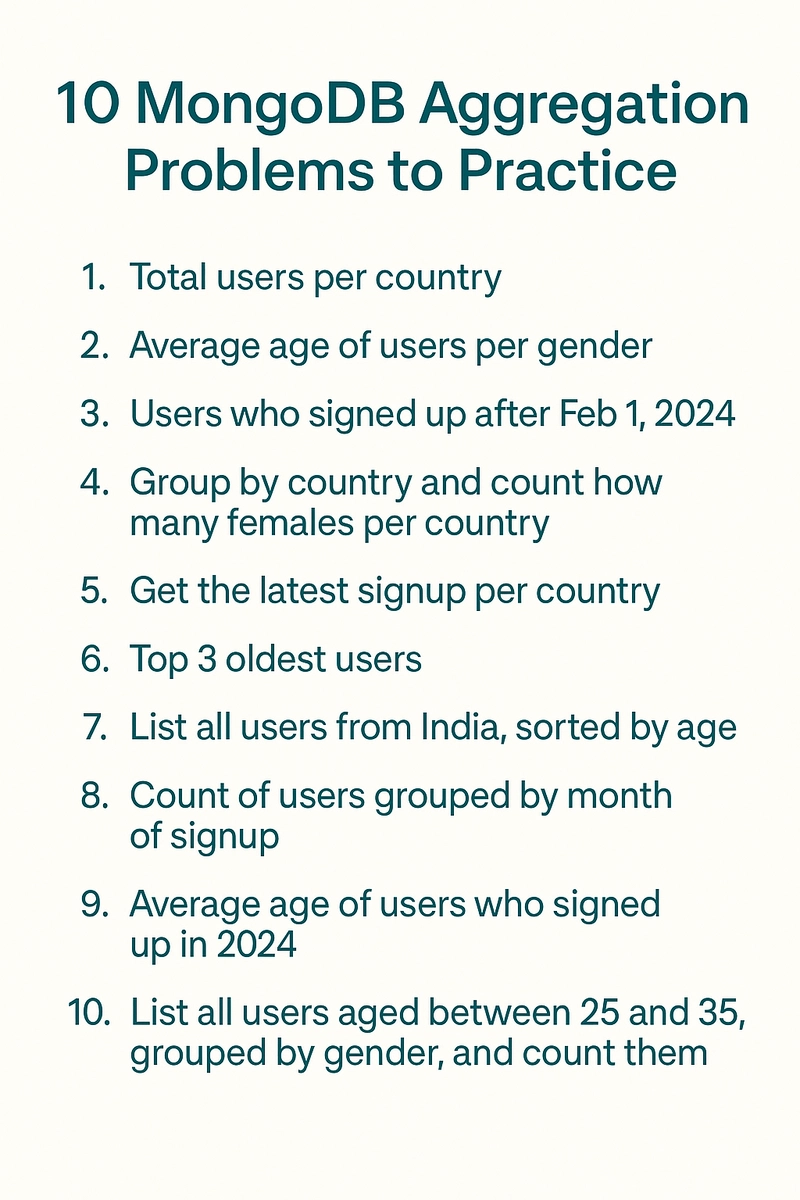Mastering MongoDB Aggregation: 10 Practical Examples with Sample Data
MongoDB's aggregation framework is powerful yet often misunderstood. Whether you're prepping for interviews, building analytics, or learning data science workflows, mastering aggregation is essential. Below are 10 real-world problems, complete with queries and explanations, using a sample dataset of users. Sample MongoDB Collection: users [ { "name": "Alice", "age": 28, "country": "USA", "gender": "female", "signupDate": "2023-12-20T10:15:00Z" }, { "name": "Bob", "age": 34, "country": "Canada", "gender": "male", "signupDate": "2024-01-15T12:00:00Z" }, { "name": "Charlie", "age": 22, "country": "India", "gender": "male", "signupDate": "2024-02-05T09:45:00Z" }, { "name": "Diana", "age": 30, "country": "USA", "gender": "female", "signupDate": "2024-03-01T08:30:00Z" }, { "name": "Eve", "age": 29, "country": "India", "gender": "female", "signupDate": "2024-01-25T11:20:00Z" }, { "name": "Frank", "age": 40, "country": "Canada", "gender": "male", "signupDate": "2024-02-10T14:50:00Z" }, { "name": "Grace", "age": 19, "country": "USA", "gender": "female", "signupDate": "2024-03-10T07:10:00Z" }, { "name": "Harry", "age": 31, "country": "UK", "gender": "male", "signupDate": "2024-03-12T17:40:00Z" }, { "name": "Ivy", "age": 27, "country": "India", "gender": "female", "signupDate": "2024-01-01T06:00:00Z" }, { "name": "Jack", "age": 36, "country": "Canada", "gender": "male", "signupDate": "2024-02-20T18:15:00Z" } ] 1. Count of Users by Country [ { $group: { _id: "$country", totalUsers: { $sum: 1 } } } ] 2. Average Age by Gender [ { $group: { _id: "$gender", averageAge: { $avg: "$age" } } } ] 3. Users Signed Up After February 1, 2024 [ { $addFields: { signupDateConverted: { $toDate: "$signupDate" } } }, { $match: { signupDateConverted: { $gte: ISODate("2024-02-01T00:00:00Z") } } } ] 4. Count of Female Users by Country [ { $match: { gender: "female" } }, { $group: { _id: "$country", femalePerCountry: { $sum: 1 } } } ] 5. Group by Country After Sorting by Signup Date (Descending) [ { $sort: { signupDate: -1 } }, { $group: { _id: "$country" } } ] 6. Get the 3 Earliest Signups [ { $sort: { signupDate: 1 } }, { $limit: 3 } ] 7. All Indian Users Sorted by Age Descending [ { $match: { country: "India" } }, { $sort: { age: -1 } } ] 8. Count of Users Grouped by Month of Signup [ { $project: { monthYear: { $dateToString: { format: "%Y-%m", date: { $toDate: "$signupDate" } } } } }, { $group: { _id: "$monthYear", userCount: { $sum: 1 } } }, { $sort: { _id: 1 } } ] 9. Average Age of Users Signed Up in 2024 [ { $project: { year: { $dateToString: { format: "%Y", date: { $toDate: "$signupDate" } } }, age: 1, name: 1, signupDate: 1 } }, { $match: { year: "2024" } }, { $group: { _id: "$year", avgAge: { $avg: "$age" } } } ] 10. Count of Users Aged 25 to 35 Grouped by Gender [ { $match: { age: { $gte: 25, $lte: 35 } } }, { $group: { _id: "$gender", count: { $sum: 1 } } } ] MongoDB aggregations are incredibly versatile. From basic groupings to complex date manipulations, they can power dashboards, reports, and analytics. Bookmark this post for reference and practice daily! Happy querying!

 MongoDB's aggregation framework is powerful yet often misunderstood. Whether you're prepping for interviews, building analytics, or learning data science workflows, mastering aggregation is essential. Below are 10 real-world problems, complete with queries and explanations, using a sample dataset of users.
MongoDB's aggregation framework is powerful yet often misunderstood. Whether you're prepping for interviews, building analytics, or learning data science workflows, mastering aggregation is essential. Below are 10 real-world problems, complete with queries and explanations, using a sample dataset of users.
Sample MongoDB Collection: users
[
{ "name": "Alice", "age": 28, "country": "USA", "gender": "female", "signupDate": "2023-12-20T10:15:00Z" },
{ "name": "Bob", "age": 34, "country": "Canada", "gender": "male", "signupDate": "2024-01-15T12:00:00Z" },
{ "name": "Charlie", "age": 22, "country": "India", "gender": "male", "signupDate": "2024-02-05T09:45:00Z" },
{ "name": "Diana", "age": 30, "country": "USA", "gender": "female", "signupDate": "2024-03-01T08:30:00Z" },
{ "name": "Eve", "age": 29, "country": "India", "gender": "female", "signupDate": "2024-01-25T11:20:00Z" },
{ "name": "Frank", "age": 40, "country": "Canada", "gender": "male", "signupDate": "2024-02-10T14:50:00Z" },
{ "name": "Grace", "age": 19, "country": "USA", "gender": "female", "signupDate": "2024-03-10T07:10:00Z" },
{ "name": "Harry", "age": 31, "country": "UK", "gender": "male", "signupDate": "2024-03-12T17:40:00Z" },
{ "name": "Ivy", "age": 27, "country": "India", "gender": "female", "signupDate": "2024-01-01T06:00:00Z" },
{ "name": "Jack", "age": 36, "country": "Canada", "gender": "male", "signupDate": "2024-02-20T18:15:00Z" }
]
1. Count of Users by Country
[
{
$group: {
_id: "$country",
totalUsers: { $sum: 1 }
}
}
]
2. Average Age by Gender
[
{
$group: {
_id: "$gender",
averageAge: { $avg: "$age" }
}
}
]
3. Users Signed Up After February 1, 2024
[
{
$addFields: {
signupDateConverted: {
$toDate: "$signupDate"
}
}
},
{
$match: {
signupDateConverted: {
$gte: ISODate("2024-02-01T00:00:00Z")
}
}
}
]
4. Count of Female Users by Country
[
{ $match: { gender: "female" } },
{
$group: {
_id: "$country",
femalePerCountry: { $sum: 1 }
}
}
]
5. Group by Country After Sorting by Signup Date (Descending)
[
{ $sort: { signupDate: -1 } },
{
$group: {
_id: "$country"
}
}
]
6. Get the 3 Earliest Signups
[
{ $sort: { signupDate: 1 } },
{ $limit: 3 }
]
7. All Indian Users Sorted by Age Descending
[
{ $match: { country: "India" } },
{ $sort: { age: -1 } }
]
8. Count of Users Grouped by Month of Signup
[
{
$project: {
monthYear: {
$dateToString: {
format: "%Y-%m",
date: { $toDate: "$signupDate" }
}
}
}
},
{
$group: {
_id: "$monthYear",
userCount: { $sum: 1 }
}
},
{ $sort: { _id: 1 } }
]
9. Average Age of Users Signed Up in 2024
[
{
$project: {
year: {
$dateToString: {
format: "%Y",
date: { $toDate: "$signupDate" }
}
},
age: 1,
name: 1,
signupDate: 1
}
},
{ $match: { year: "2024" } },
{
$group: {
_id: "$year",
avgAge: { $avg: "$age" }
}
}
]
10. Count of Users Aged 25 to 35 Grouped by Gender
[
{
$match: {
age: { $gte: 25, $lte: 35 }
}
},
{
$group: {
_id: "$gender",
count: { $sum: 1 }
}
}
]
MongoDB aggregations are incredibly versatile. From basic groupings to complex date manipulations, they can power dashboards, reports, and analytics. Bookmark this post for reference and practice daily!
Happy querying!











































































































































































![[The AI Show Episode 144]: ChatGPT’s New Memory, Shopify CEO’s Leaked “AI First” Memo, Google Cloud Next Releases, o3 and o4-mini Coming Soon & Llama 4’s Rocky Launch](https://www.marketingaiinstitute.com/hubfs/ep%20144%20cover.png)

































































































































![[DEALS] Sterling Stock Picker: Lifetime Subscription (85% off) & Other Deals Up To 98% Off – Offers End Soon!](https://www.javacodegeeks.com/wp-content/uploads/2012/12/jcg-logo.jpg)










































































































.jpg?#)






















































































































































![Apple to Shift Robotics Unit From AI Division to Hardware Engineering [Report]](https://www.iclarified.com/images/news/97128/97128/97128-640.jpg)

![Apple Shares New Ad for iPhone 16: 'Trust Issues' [Video]](https://www.iclarified.com/images/news/97125/97125/97125-640.jpg)


































































































































![[AI 동향] 2025-03-07 기술 동향 정리 및 분석](https://media2.dev.to/dynamic/image/width%3D1000,height%3D500,fit%3Dcover,gravity%3Dauto,format%3Dauto/https:%2F%2Fdev-to-uploads.s3.amazonaws.com%2Fuploads%2Farticles%2Fex27wpl1ilaswltt9i9q.png)
